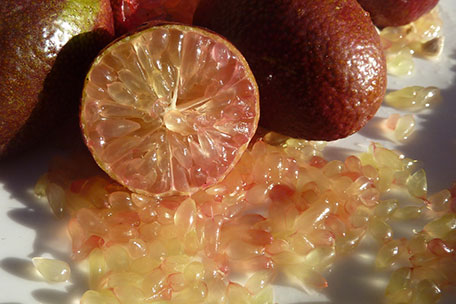
The Red Lime is hybrid between the Australian native finger lime, (Citrus Australasica) and a Burmese Rangpur lime, (Citrus x Limonia). Also known as Red Centre Lime, its actual registered PBR name is Australian Blood Lime. (*See details of complete breeding program below.)
When ripe, a beautiful burgundy/red colour, oval in shape, around the size of a small hen egg. Its bounty is an abundance of juice and juice filled vesicles (small teardrop shaped sacks filled with slightly tart, aromatic juice, bursting with flavour.) This attribute is the reason we choose to call our Red limes the ‘Citrus sensation' while their relatives, the Australian Finger lime have juice only in the citrus pearls held in side, that burst on the palate, the Red Lime is full of juice making it ideal for dishes and drinks that call for " the juice of a…lemon..or…lime “ now we have, the Australian Red Lime.

The flesh of the Red lime, the' teardrop shaped caviar', develops different colours as the fruit continues to ripen.
Early harvest fruit will have a lemon /lime coloured flesh. As fruit continues to ripen the colours change to more pink/orange hues, and finally when fully ripe flesh can become quite dark pink. Even though the Red lime is also known as blood lime, it won’t develop the strong blood red colour of a blood orange. The flavours of the juice and ‘caviar’ at each stage of ripeness are well balanced with superb acid-sweetness balance.
This ‘teardrop caviar’ can easily be separated from the juice so that it can be used in the same way as the Finger lime. Colours may not be as vivid as the Fingerlime, but the juice filled globules display a range of colour , hold 2 -3 times as much juice as the Fingerlime caviar, and burst on the palate , truly a ‘taste sensation.'



Red limes grow on a small leafed thorny tree with a slightly weeping habit that if left unpruned may reach 2.5 metres. At Gondwana Native limes we are experimenting with growing our trees in row crops forming dense but manageable large hedges.
The trees are growing extremely well and showing the benefits of the extensive preparation done on the orchards prior to planting, using only environmentally friendly natural composts, fertilisers, minerals and vermicast, and continued sustainable management practices ensuring maximum soil health and fertility.
Thanks to Nutritech, EAL, Southern Cross University, Paul Dalley/ Grandiflora, Todd/Virida Sylvis, IntuneEarth worm farm & Northern Nursery supplies, for their on going supply of materials and advice.

Our trees are grafted onto either Trifoliata rootstock or Troyer Citrange. The majority of the orchard, approx 1300 trees, was planted 2011/2012 with subsequent plantings 2013 of Finger Limes.
Our trees have now been growing vigoursly for four years, this tree is displaying a good yield of possibly over 1000 fruit, that will be picked according to ripeness over the next two months.
I’d like to thank Gary Eyles and crew for producing the majority of our Finger Limes and all the Red Limes, Eyles Nursery at Kenthurst is the only licenced propagator of Red Limes in NSW.
DOWNLOAD OUR RED LIME BROCHURE CLICK HERE >>
‘Australian Blood’ Application No: 1996/277 Accepted: 14 Feb 1997. Applicant: CSIRO, Canberra, ACT. Agent: Australian Native Produce Industries Pty Ltd, Paringa, SA.
Characteristics Plant: tree shape obloid, main branches drooping, growth habit drooping, canopy dense, branch angle wide, tree height 2-2.5m, vigour strong, trunk surface smooth. Stem: shoot tip colour purple (anthocyanin present), shoot tip surface glabrous.
Spine (Thorn): present, length 6-15mm, shape straight, distribution axillary at every node.
Leaf: evergreen, type simple, shape ovate, intensity of green colour on lamina dark, margin crenate, shape of apex acute/slightly emarginate, lamina cross section concave, lamina undulation absent, lamina firmness medium, lamina attachment brevipetiolate, lamina shape ovate, petiole wings very small, petiole attachment straight, petiole wing width narrow, petiole wing shape obdeltate, junction between petiole and lamina articulate, lamina upper surface darker than lower surface.
Flower: abundant, hermaphrodite and male, flower bud anthocyanin coloration, arrangement solitary and as a raceme, position axillary and terminal, habit flowering once per year, pedicel length 2-4mm, calyx diameter 4-5mm, length of anther relative to stigma same, colour internally white with purple at base of petals, externally purple, anthers yellow, 5 petals per flower, petal length 10-11mm, stamens 4 - <4 per petal, pollen viable, style straight and complete.
Fruit: borne both inside (mainly) and outside canopy, size small, rind thin, medium adherence of rind to flesh, rind colour red to red-orange to burgundy, shape ovoid to ellipsoid, shape of base convex to rounded, shape of apex rounded to truncate, surface texture smooth to pebbled, albedo adherence medium, oil glands conspicuous, density of rind oil glands low – intermediate, size of oil glands small, albedo colour pinkish to reddish, main colour of fruit in cross section red to pink, length 30-50mm, diameter 20-30mm, pulp colour at maturity orange-red to red, pulp colour uniformity maybe streaked depending on maturity and climate, number of segments 5-9, juiciness medium to high, juice pink, segments uniform, axis solid to round, texture fleshy, juice acidity high-very high, maturity mid-season (Jun-Jul). Seed: number 1-9, shape variable, surface wrinkled, surface cream, cotyledons green (medium), chalazal spot light brown (beige), monoembryonic.
Origin and Breeding Open pollination: ‘Australian Blood’ lime was identified from progeny of open-pollinated seedlings grown from seeds of a zygotic seedling of Rangpur lime grown adjacent to a row of Citrus australasica var. sanguinea seedlings (red-flesh finger limes). Rangpur lime is a citrus rootstock cultivar that yields acid mandarin-like fruits. It has the botanical name of Citrus x limonia (Watson et al, 1984). The seedlings from which the ‘Australian Blood’ lime was identified were culled from other seedlings of the zygotic Rangpur lime seedling based on the obvious Citrus australasica habit and characteristics that they displayed. As a consequence of these characteristics, it is assumed that the pollen parent of the Australian Blood lime was a seedling of C. australasica var. sanguinea. The seedlings with C. australasica habit and characteristics were rowed out for field evaluation and monitoring for growth habit, fruit yield and characteristics. The Australian Blood lime was selected in 1990 when 12 trees were propagated as rooted cuttings for further evaluation. Selection criteria: it was selected for the culinary qualities of its striking red, highly aromatic acid fruits. ‘Australian Blood’ lime will be propagated vegetatively by grafting or budding to standard citrus rootstocks.
Breeder: Dr. S.R. Sykes, CSIRO Plant Industry (Horticulture Unit), Merbein, VIC.

